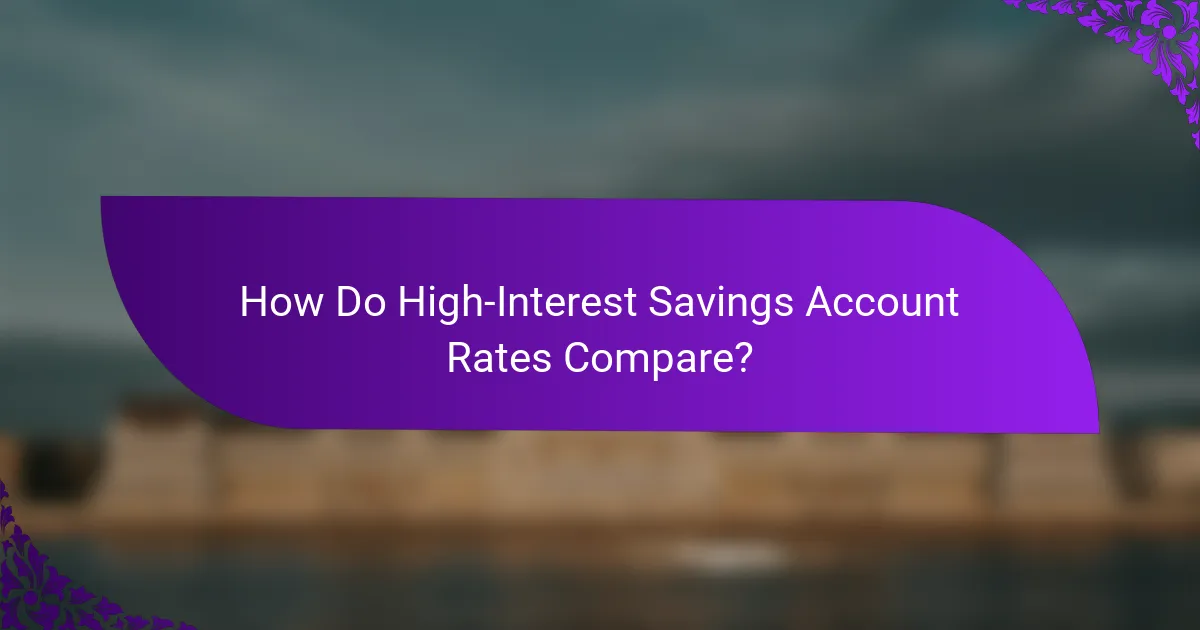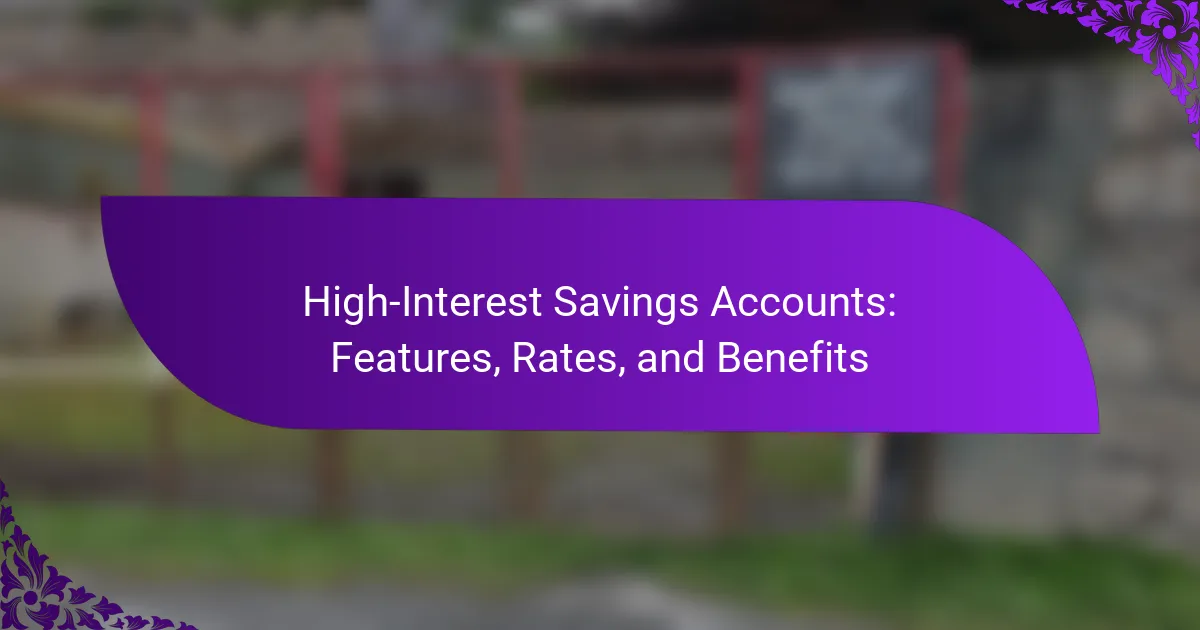High-interest savings accounts are specialized bank accounts that provide significantly higher interest rates than traditional savings accounts, allowing individuals to grow their savings more effectively. These accounts combine the benefits of liquidity and lower risk, making them an attractive option for those looking to enhance their savings while maintaining easy access to their funds.

What Are High-Interest Savings Accounts?
High-interest savings accounts are specialized bank accounts that offer significantly higher interest rates compared to traditional savings accounts. They are designed to help individuals grow their savings more effectively while still providing easy access to their funds.
Definition of high-interest savings accounts
A high-interest savings account is a type of deposit account that typically offers interest rates that are several times higher than the national average for standard savings accounts. These accounts are often offered by online banks or credit unions, which can afford to provide better rates due to lower overhead costs.
Funds in these accounts are usually insured by the government up to a certain limit, providing security for depositors. They are ideal for individuals looking to save for short-term goals while earning a competitive return on their deposits.
Comparison to traditional savings accounts
High-interest savings accounts generally offer interest rates that can range from 1% to over 3%, while traditional savings accounts often yield rates below 1%. This difference can significantly impact the growth of savings over time.
Additionally, high-interest accounts may have fewer fees and lower minimum balance requirements than traditional options. However, they may also come with certain limitations, such as restrictions on the number of withdrawals per month.
Common features of high-interest savings accounts
Common features of high-interest savings accounts include competitive interest rates, easy online access, and minimal fees. Many accounts offer no monthly maintenance fees, making them cost-effective for savers.
Additionally, these accounts often allow for easy transfers to and from checking accounts, enabling quick access to funds when needed. Some banks may also provide mobile banking features, making it convenient to manage savings on the go.

What Are the Benefits of High-Interest Savings Accounts?
High-interest savings accounts offer several advantages, primarily higher interest rates, liquidity, and lower risk compared to other investment options. These accounts are designed to help individuals grow their savings while maintaining easy access to their funds.
Higher interest rates than regular accounts
High-interest savings accounts typically provide interest rates that are significantly higher than those of standard savings accounts. While traditional accounts may offer rates in the low single digits, high-interest options can yield rates in the low to mid single digits, depending on the financial institution and market conditions.
Choosing a high-interest savings account can lead to better returns on your savings over time. For instance, if you deposit $10,000 at a 2% interest rate, you could earn around $200 in interest annually, compared to much lower earnings from a regular account.
Liquidity and easy access to funds
One of the key benefits of high-interest savings accounts is their liquidity, allowing you to access your funds quickly without penalties. Most accounts permit a certain number of withdrawals per month, making it easy to manage your cash flow while still earning interest.
This accessibility is ideal for emergency funds or short-term savings goals, as you can withdraw money when needed without sacrificing your interest earnings. However, be aware of any limitations on withdrawals to avoid fees.
Low risk compared to investments
High-interest savings accounts are considered low-risk compared to other investment vehicles like stocks or mutual funds. Your deposits are typically insured by government agencies, such as the FDIC in the United States, up to a certain limit, providing peace of mind that your money is safe.
This low-risk nature makes high-interest savings accounts an attractive option for conservative savers who want to avoid market volatility while still earning a reasonable return on their funds. They serve as a stable foundation for your overall financial strategy.

How Do High-Interest Savings Account Rates Compare?
High-interest savings account rates vary significantly among financial institutions, influenced by market conditions and individual bank policies. Generally, these rates can range from low percentages to competitive figures that can significantly enhance your savings over time.
Current average rates in the US
As of late 2023, the average interest rate for high-interest savings accounts in the US typically falls between 0.5% and 2.0%. Rates can fluctuate based on the Federal Reserve’s monetary policy and economic conditions, so it’s wise to regularly check for updates.
Many online banks tend to offer higher rates compared to traditional brick-and-mortar institutions, making them a popular choice for savers looking to maximize their returns.
Top providers and their rates
Some of the top providers for high-interest savings accounts include online banks like Ally, Marcus by Goldman Sachs, and American Express Bank. Rates at these institutions often range from 1.5% to 2.5%, depending on the account balance and current promotions.
It’s beneficial to compare not only the interest rates but also any associated fees or minimum balance requirements, as these can impact your overall earnings.
Factors affecting interest rates
Several factors influence the interest rates offered on high-interest savings accounts, including the overall economic environment, competition among banks, and the Federal Reserve’s interest rate decisions. When the economy is strong, rates tend to rise, while in weaker conditions, they may decrease.
Additionally, banks may adjust their rates based on their funding needs and the desire to attract new customers. Keeping an eye on these factors can help you choose the best time to open or switch accounts for optimal returns.

What Should You Consider When Choosing a High-Interest Savings Account?
When selecting a high-interest savings account, focus on key factors such as fees, minimum balance requirements, accessibility, and security. Understanding these elements will help you maximize your savings and ensure your funds are safe and easily accessible.
Fees and minimum balance requirements
Many high-interest savings accounts come with various fees and minimum balance requirements that can impact your overall returns. Look for accounts with no monthly maintenance fees and low or no minimum balance thresholds to avoid unnecessary charges.
For instance, some banks may require a minimum balance of $100 to $1,000 to earn the advertised interest rate. If you frequently dip below this amount, you might lose out on interest or incur fees, so choose an account that aligns with your savings habits.
Accessibility and online banking features
Accessibility is crucial when choosing a high-interest savings account. Ensure the bank offers a user-friendly online banking platform, mobile app, and easy access to your funds through ATMs or branch locations.
Look for features like mobile check deposit, fund transfers, and account alerts. These conveniences can enhance your banking experience and help you manage your savings more effectively.
FDIC insurance and security
FDIC insurance is vital for protecting your deposits in a high-interest savings account. Accounts insured by the Federal Deposit Insurance Corporation (FDIC) cover up to $250,000 per depositor, per bank, ensuring your money is safe even if the bank fails.
Additionally, consider the bank’s security measures, such as encryption and fraud detection systems. A reputable institution will prioritize your financial security, giving you peace of mind as you save.

How Do High-Interest Savings Accounts Work?
High-interest savings accounts (HISAs) are designed to offer higher interest rates than traditional savings accounts, allowing your money to grow faster. They typically provide easy access to funds while still offering competitive returns, making them an attractive option for savers looking to maximize their earnings.
Interest calculation methods
Interest on high-interest savings accounts is usually calculated using either simple or compound interest. Simple interest is calculated only on the principal amount, while compound interest is calculated on the principal plus any interest earned, leading to potentially higher returns over time.
Most HISAs use compound interest, which can be calculated daily, monthly, or annually. Daily compounding is often the most beneficial, as it allows interest to be added to the account balance more frequently, increasing the overall earnings.
Compounding frequency
The frequency of compounding can significantly affect the amount of interest you earn. Common compounding frequencies include daily, monthly, quarterly, and annually. Daily compounding generally yields the highest returns, as interest is calculated and added to your balance every day.
When comparing HISAs, look for those that offer daily compounding to maximize your interest earnings. Even small differences in compounding frequency can lead to noticeable differences in your total interest over time.
Withdrawal limits and penalties
High-interest savings accounts often come with withdrawal limits to encourage saving. Many banks allow a certain number of withdrawals per month, typically ranging from three to six. Exceeding this limit may result in fees or a reduction in interest rates.
Before opening a HISA, review the account’s terms regarding withdrawals and any associated penalties. Understanding these limits can help you avoid unexpected fees and ensure that the account aligns with your financial needs.

What Are the Alternatives to High-Interest Savings Accounts?
Alternatives to high-interest savings accounts include various financial products that can provide competitive interest rates and liquidity. Options such as money market accounts, certificates of deposit, and investment accounts may offer different benefits depending on your financial goals and needs.
Money market accounts
Money market accounts (MMAs) are a type of savings account that typically offers higher interest rates than traditional savings accounts while allowing limited check-writing and debit card access. They often require a higher minimum balance, which can range from a few hundred to several thousand dollars.
When considering a money market account, evaluate the interest rates, fees, and withdrawal limits. Rates can vary significantly, often falling between 0.5% and 2.5%, depending on the financial institution and current market conditions.
To maximize your returns, look for accounts with no monthly maintenance fees and competitive interest rates. Be cautious of accounts that require high minimum balances, as failing to meet these can result in fees that diminish your earnings.
